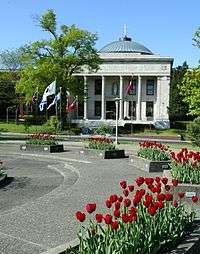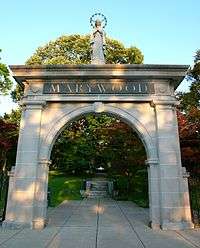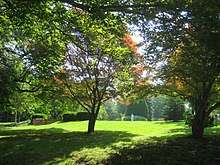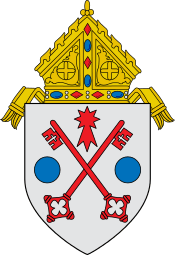Marywood University
 | |
| Motto | Sanctitas Scientia Sanitas |
|---|---|
Motto in English | Holiness, Knowledge, Health |
| Type | Private liberal arts university |
| Established | 1915 |
| Affiliation |
Roman Catholic (Sisters, Servants of the Immaculate Heart of Mary) |
| Endowment | $23.9 million[1] |
| President | Sr. Mary Persico, I.H.M., Ed.D. |
Administrative staff | 259 |
| Undergraduates | 2,000+ |
| Postgraduates | 1,300+ |
| Location | Scranton, Pennsylvania, United States |
| Campus | Suburban, 115 acres (0.47 km2) |
| Colors | Forest green and white |
| Athletics | NCAA Division III – CSAC, ECAC |
| Nickname | Pacers |
| Affiliations |
ACCU NAICU CIC MSA |
| Sports | 11 varsity teams |
| Website | www.marywood.edu |
 | |
Marywood University is a co-educational, Catholic liberal arts university located on a 115-acre (0.47 km2) campus in Scranton, Pennsylvania, United States, within the Diocese of Scranton. Established in 1915 by the Sisters, Servants of the Immaculate Heart of Mary, Marywood currently enrolls more than 3,400 students in a variety of undergraduate, graduate, and doctoral programs.[2] The university has a national arboretum[3] with more than 100 types of trees and shrubs.[4] Marywood's Catholic identity coupled with its mission to educate students to "live responsibility in an interdependent world" encourages students to be socially responsible agents of change.
History
The Sisters, Servants of the Immaculate Heart of Mary came to Scranton, Pennsylvania, and established St. Cecilia's Academy in 1878 "for young ladies". Mount St. Mary's Seminary opened in 1902. Mother Cyril Conroy, superior in 1901, deliberately chose the term "seminary" (roughly equivalent to a high school in present times) to avoid the suggestion of a finishing school – which was a much more common destination at that time for older girls who could afford to continue their education – as it was intended to be "a place where young scholars dedicated themselves to serious study". The Motherhouse was co-located with the seminary. Its buildings suffered major damage during a fire in the 1970s. As a result, the Jesuit Scranton Preparatory School, then a boys' school, became co-educational to accommodate the girls.[5] The arch, now known as "Memorial Arch", which stood at the entrance to the seminary-cum-motherhouse, still stands on the present-day campus and the former seminary's name can be seen engraved on it.
The seminary was the next time step to the Sisters' ultimate goal: to open a women's college in Scranton. Marywood College opened with 34 students and Mother Germaine O'Neil as president and treasurer. It was the fifth Catholic women's college in the United States.[6] The first batch of students graduated in 1919 with a Bachelor of Arts, Bachelor of Science, or Bachelor of Letters. By the 1930s, the college had diversified its curriculum, offering subjects ranging from the social sciences to pre-medical.[7] In 1937, the Sisters turned down an invitation to merge with St. Thomas College, then under the Christian Brothers. St. Thomas later came under the administration of the Jesuits after World War II and is now the University of Scranton.[8]
By the 1970s, other single-sex Catholic colleges and universities in the Diocese such as College Misericordia and King's College were becoming co-educational and Marywood followed suit, opening its doors to male students in the fall of 1989.[9] In 1997 it was granted university status by the Pennsylvania Department of Education.[10]
Academics
Marywood's programs are administered through four degree-granting colleges, with 60 bachelor's degree, 36 master's degree, two doctoral degrees, two terminal degrees by program (MFA, Ed.S.). All students are required to complete a core curriculum in the liberal arts in addition to the courses in their major. Undergraduates may also enroll in double majors, honors, and independent study programs, practicums, internships, and study abroad, as well as Army and Air Force ROTC programs.
Athletics
Marywood University is an NCAA Division III school and member of the Atlantic East Conference. The official name given is the Marywood Pacers. Marywood competes at the varsity level in baseball, basketball, cross-country, field hockey, golf, lacrosse, soccer, softball, swimming and diving, tennis, and volleyball.[11] In addition, Marywood has announced it will add track and field to its roster of varsity sports in 2014.[12] Students may also choose from more than 30 intramural programs, including club sports, as well as fitness options, recreational classes, and activity clubs.
Campus buildings and landmarks

- The Aquatics Center, opened in 2011, has an 8-lane NCAA regulation pool, 3-meter diving board, 1-meter diving boards, competition gutters, and seating for 200 spectators.
- The Center for Natural and Health Sciences houses several academic departments, including Mathematics, Science, Nursing, and Administrative Studies.
- The Swartz Center for Spiritual Life, opened in 2007, contains the Marian Chapel, Campus Ministry, and Conference and Event Services.
- The Fricchione Day Care Center, built in 1991, is a child development center for children of Marywood staff, faculty, and students.
- Immaculata Hall was built in the 1950s. It was originally called Alumnae Hall, and it was renamed to honor Sister M. Immaculata Gillespie, Marywood's first dean. It houses the President's Office and the Office of Planning and Institutional Research.
- The Insalaco Center for Studio Arts, completed in 2001, houses the Kresge Gallery and features drawing and painting studios showcasing naturally-lit rooms with fine views of the campus. There are studios and equipment for woodworking, fiber arts, jewelry-making, ceramics, sculpture, photography, printmaking, a computer Mac lab, and private and semi-private studios for upper level BFA, MA, and MFA students.
- The Learning Resources Center, opened in 1968, houses the University's main library.
- The Learning Commons, is a 21st Century library that focuses on actively empowering the learner. It is a scholars’ gathering place, where students from all disciplines converge, collaborate, and expand their horizons ever further. The facility includes traditional library services & facilities, a state of the art automatic book-retrieval system, knowledge bar & atrium, regional archives, center for Communication Arts, entrepreneurial launchpad, center for transformational teaching and learning, private and group study rooms, a cafe, audio/visual rooms, seminar rooms, and a memorial garden.
- The Liberal Arts Center houses many academic departments, including Religious Studies, Philosophy, Social Sciences, English, and Foreign Languages. The Admissions Office is also located here.
- Maria Hall, one of the original campus structures, now houses the University Development/Advancement Office.
- The Media Center is home to TV Marywood and WVMW-FM 91.7.
- The Center for Athletics and Wellness includes a 1,500 seat arena, a 5,000-square-foot (460 m2) fitness center, and other athletic facilities.
- The Memorial Arch, built in 1902, originally held the inscription "Mt. St. Mary's" and marked the entrance to the original Motherhouse, which was the location of Mt. St. Mary's seminary. Even though the Motherhouse was destroyed by fire in 1971, the arch still stands as the welcoming landmark at the entrance of the campus. The statue of the Virgin Mary on top of the arch is often referred to by students as the "Electric Mary" due to its halo encircled by light bulbs. The original stone steps to the Motherhouse are behind the arch.

- The Memorial Commons was built in 1975 as a memorial to the original IHM Motherhouse that burned down in 1971.
- The Nazareth Student Center, built in 1964, houses the main dining room, a lounge, a game room, the university bookstore, the Office of Student Activities and Leadership Development, and other university offices.
- The O'Neill Center for Healthy Families, built in 2002, houses academic programs and research facilities.
- The Rotunda adorns Marywood's Liberal Arts Center.
- The Sette LaVerghetta Center for Performing Arts, built in the 1950s as Assumption Hall, was rededicated in honor of Sette LaVerghetta in 1998. It houses the Communication Arts and Music departments.
- The Center for Architectural Studies, completed in fall 2009, is a state-of-the-art example of sustainable design. It is a spacious, adaptive re-use of Marywood's former gymnasium. It has two levels of studios, a woodshop, a computer-aided design (CAD) laboratory, and a student lounge. It houses the region's first and only school of architecture.
- The Tony Domiano Early Childhood Center, built in 2000, provides space for about 60 children in pre-school and kindergarten.
- The Shields Center for Visual Arts serves Marywood's art students. It has classroom space for the graphic design, illustration, art history, and art therapy programs, as well as a 24-hour drop-in Mac lab. It also houses three art galleries: Mahady Gallery, Suraci Gallery, and Maslow Study Gallery.
- The McGowan Center for Graduate and Professional Studies, renovated in 1998, was previously known as the Center for Human Services. It houses the Reap College of Education and Human Development and the Counseling/Student Development Center.
- The Veterans Resource Center, formerly Bethany Hall, houses the Office of Military and Veteran Services and provides a gathering place for the Student Veteran Alliance. Student veterans are welcome to use the center's community lounge, quiet study space, and kitchen.
Housing
- Loughran Hall is a residence hall for freshman students only and accommodates up to 324. Room doors are secured through a card access system and a staffed security desk is located on the terrace level of the building. There are ADA compliant rooms which are handicap accessible. Laundry rooms, study rooms, TV rooms, and public use microwaves are located on several floors. This building is connected to the Swartz Center for Spiritual Life.
- Madonna Hall is an upperclassmen residence hall with co-educational floors. Room doors are secured through a card access system and a staffed security desk is located on the first floor of the building. There are ADA compliant rooms which are handicap accessible. Laundry rooms are located on each floor of the building. Study areas are located on multiple floors. Madonna Hall has a professional kitchen and a small movie theatre for resident use.
- Regina Hall, originally named O'Reilly Hall, was the first student residence built at Marywood in the late 1920s. After the Motherhouse was destroyed by fire in 1971, the area that had once been the formal dining room was converted for use as a chapel. The chapel was then converted to what is now the Liguori Center. Regina Hall is still a residence hall today.
- Immaculata Hall,(Closed) originally built in the 1950s and named Alumnae Hall, was later renamed Immaculata Hall to honor Sister M. Immaculata Gillespie, Marywood's first dean. Immaculata has two floors of single-room dorms for resident students.
- Emmanuel Hall(Closed) provides specialty housing for 25 upperclass students in primarily 4-person rooms. The residence includes a kitchen and large common area.
- Perpetual Help Hall(Closed) houses up to 14 male resident students. and includes a living room, kitchen, study area, and laundry room.
- McCarty Hall,(Closed) dedicated in November 1941, was once used as a practice house for students majoring in vocational home economics. The hall burnt down and is no longer used for residents.
- The Woodland Residences provide apartment-style living for sophomores, juniors, and seniors. Each unit houses between four, five or ten upperclass students.
Notable alumni
- Sister Adrian Barrett, Roman Catholic nun, educator, and social worker
- Colette Cassidy, primetime newsbreak presenter for MSNBC
- Michele Knotz, voice actress for anime such as Pokémon
- Christian Haskett, professor of religion at Centre College
- Archbishop Joseph Kurtz, president of the U.S. Conference of Catholic Bishops
- Ben Walsh and Adam McIlwee, guitarists for tigers jaw
- Lee Namey (Master's of fine arts, 1971), Mayor of Wilkes-Barre, Pennsylvania (1988-1996)[13]
- Jean Kerr, née Bridget Jean Collins, playwright and author, Please Don't Eat the Daisies.
Arboretum

Marywood University was declared an arboretum in 1975 in honor of Sister Maria Laurence Maher, then Professor of Biological Sciences, and received its official designation as such in 1997. It now contains 42 species of trees (103 varieties) and a comparable collection of shrubs, ornamental grasses, and flowers.[14]
References
- ↑ As of June 30, 2009. "U.S. and Canadian Institutions Listed by Fiscal Year 2009 Endowment Market Value and Percentage Change in Endowment Market Value from FY 2008 to FY 2009" (PDF). 2009 NACUBO-Commonfund Study of Endowments. National Association of College and University Business Officers. Archived from the original (PDF) on 2010-04-01. Retrieved February 10, 2010.
- ↑ "Marywood University".
- ↑ "New Arboretum Sets Down Roots at Wilkes".
- ↑ "About the Arboretum".
- ↑ "Scranton Prep History". scrantonprep.com.
- ↑ Steadfast in the Faith: The Life of Patrick Cardinal O'Boyle. CUA Press. 2006. p. 17. ISBN 9780813214290.
- ↑ Dunn, Josephine Marie; Kashuba, Cheryl A. (2007). Images of America — The Women of Scranton: 1880-1935. Arcadia Publishing. pp. 59–61. ISBN 9780738538587.
- ↑ "President's Page: Road to the Centennial". marywood.edu. Archived from the original on 2014-04-09. Retrieved 2014-05-02.
- ↑ Gallagher, John P. A second century begins: the Diocese of Scranton, 1968-1993. Roman Catholic Diocese of Scranton. p. 62.
- ↑ "Chronological History of Marywood: 1997". marywood.edu.
- ↑ "Marywood University Pacers". marywoodpacers.com. Retrieved 2017-07-15.
- ↑ "Marywood Announces Addition of Outdoor Track and Field". marywoodpacers.com. Retrieved 2017-07-15.
- ↑ Butler, Michael P. (March 5, 2014). "Former Wilkes-Barre mayor Namey dies". The Citizens' Voice. Retrieved March 30, 2014.
- ↑ "Marywood University Arboretum". Marywood University. Retrieved 2017-07-15.
External links
| Wikimedia Commons has media related to Marywood University. |
